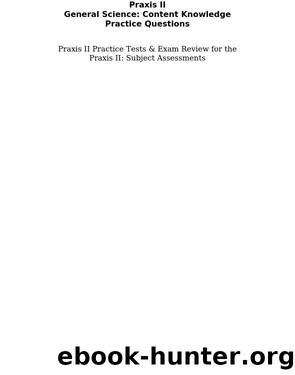Praxis II General Science: Content Knowledge Practice Questions by Praxis II Exam Secrets Test Prep Staff

Author:Praxis II Exam Secrets Test Prep Staff
Language: eng
Format: epub
Publisher: Mometrix Media LLC
a. coulombs per second
b. volts per ohm
c. electrons per second
d. Watt-volts.
32. Which of the following devices changes chemical energy into electrical energy?
a. battery
b. closed electric circuit
c. generator
d. transformer
33. A circuit consists of a battery and a resistor. An ammeter is used to measure the current in the circuit and is connected in series to the circuit. Which of the following is true?
a. The current flowing in the resistor increases.
b. The current flowing in the resistor decreases.
c. The voltage drop across the resistor increases.
d. The current flowing in the resistor remains the same.
34. A capacitor is connected in series to a battery and a resistor. The battery is disconnected after the capacitor is charged and replaced by a battery with a greater electromotive force, causing the capacitor to gain additional charge. After the capacitor has fully charged again, which of the following statements is true about the capacitance of the circuit?
a. It has increased.
b. It has decreased.
c. It has remained the same.
d. It has become zero.
35. When light from a single source strikes two slits, alternating bright and dark lines appear on a screen on the far side. What is the best explanation for this phenomenon?
a. Doppler shift
b. Diffraction and interference
c. Chromatic aberration
d. Total internal reflection
36. Which of the following is true about a diffraction grating?
a. The more slits per inch, the greater the amount of destructive interference.
b. Blue light diffracts more than red light in a diffraction grating.
c. A diffraction grating produces maxima and minima only for monochromatic light.
d. Light passing through a diffraction grating produces a bulls-eye pattern.
37. Which of the following statements best explains why light is polarized?
a. Light wavesâ electromagnetic fields can be oriented in a particular direction by a polarizer.
b. Photons of light can be pointed in the same direction by microscopic holes in a polarizer.
c. Light travels in a vacuum.
d. Light is a longitudinal wave.
38. Which of the following phenomena is most closely related to the phenomenon that produces the light from lasers?
a. radioactivity
b. phosphorescence
c. sunlight
d. blackbody radiation
39. Which of the following statements explains what causes a rainbow?
a. The components of sunlight strike water droplets at different angles.
b. Water molecules produce an emission spectrum when sunlight strikes them.
c. The speed of light in water depends on its wavelength.
d. There is total internal reflection for certain wavelengths of sunlight.
40. Which of the following theories best explains the phenomenon of total internal reflection?
a. The speed of light is a maximum in a vacuum.
b. Light consists of bundles of energy called photons.
c. Snellâs law places a limit on the angle of refraction.
d. Light consists of transverse waves.
41. Two rays parallel to the optical axis of a concave mirror are incident upon the mirror. Where do the two rays intersect?
a. At a point behind the mirror.
b. At infinity.
c. At the center of curvature.
d. At the focal point.
42. An object is 20 cm in front of a thin convex lens with a focal point of 10 cm. Where is the image located?
a. 10 cm in front of the lens.
b. 20 cm in front of the lens.
Download
This site does not store any files on its server. We only index and link to content provided by other sites. Please contact the content providers to delete copyright contents if any and email us, we'll remove relevant links or contents immediately.
| Arts & Humanities | Health |
| Language Arts | Library Skills |
| Mathematics | Reading & Phonics |
| Science & Technology | Social Studies |
The Art of Coaching Workbook by Elena Aguilar(48422)
Trainspotting by Irvine Welsh(20116)
Twilight of the Idols With the Antichrist and Ecce Homo by Friedrich Nietzsche(17736)
Fangirl by Rainbow Rowell(7874)
Periodization Training for Sports by Tudor Bompa(7361)
Change Your Questions, Change Your Life by Marilee Adams(6685)
This Is How You Lose Her by Junot Diaz(5829)
Grit by Angela Duckworth(4760)
Red Sparrow by Jason Matthews(4719)
Asking the Right Questions: A Guide to Critical Thinking by M. Neil Browne & Stuart M. Keeley(4626)
Paper Towns by Green John(4193)
Room 212 by Kate Stewart(4137)
Ken Follett - World without end by Ken Follett(3992)
The Sports Rules Book by Human Kinetics(3616)
Housekeeping by Marilynne Robinson(3443)
The Motorcycle Diaries by Ernesto Che Guevara(3364)
Introduction to Kinesiology by Shirl J. Hoffman(3317)
Exercise Technique Manual for Resistance Training by National Strength & Conditioning Association(3317)
Double Down (Diary of a Wimpy Kid Book 11) by Jeff Kinney(3302)
